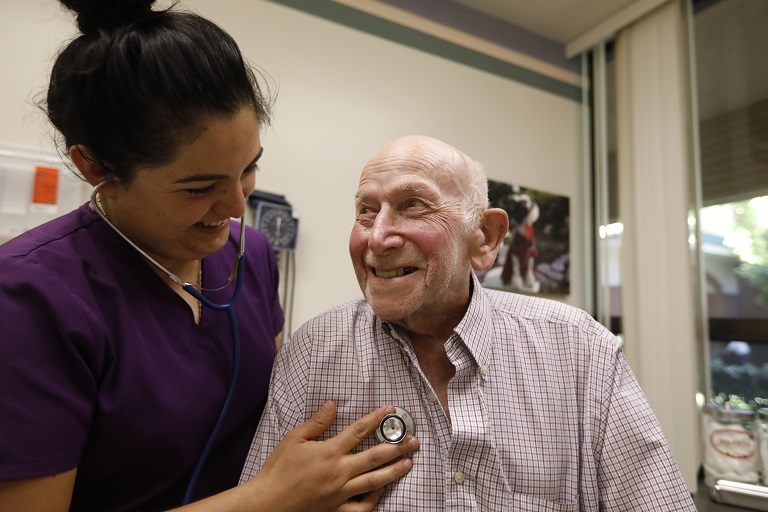LZ 200 Finds Telehealth and Data Analytics on the Rise
In 2020, as the nation’s largest not-for-profit senior living providers grappled with the pandemic’s impacts, they significantly increased their use of telehealth, social connectedness technologies, and data analytics, according to the newly released LeadingAge Ziegler 200, or LZ 200.
This annual compilation of the largest 200 not-for-profit senior living providers in the United States, now in its 18th edition, comes from a LeadingAge partnership with Ziegler. A LeadingAge Gold Partner with CAST Focus, Ziegler is one of the nation’s leading underwriters of financing for not-for-profit senior living providers.
Section 4-19a of the report, which starts on page 148, shares the technology-related data.
Key Findings
As one might expect in a pandemic year, use of telehealth/remote patient monitoring (RPM) increased substantially. In 2020, 44% of LZ 200 communities used these technologies, up from only 20% in 2019.
“The impact of the pandemic was clearly reflected in the data,” said Majd Alwan, senior vice president of technology & business strategy, and CAST executive director. “The pandemic and the related health emergency waivers have significantly driven the adoption of telehealth,” he added.
Social connectedness and engagement technologies continued their two-year rise, with adoption climbing appreciably from 50% in 2018 and 61% in 2019 to 66% in 2020.
“Of course, COVID-19 also continued to drive providers to increase their adoption of social connectedness and engagement technologies, to counteract the impacts of the pandemic on residents’ social activities,” Alwan reflected.
New pandemic-prompted technology categories found that half of LZ 200 communities used technology to prevent infection in 2020—51% used staff and resident screening technologies, and 50% used infection control, including disinfection, technologies.
LZ 200 communities are also looking at their data more strategically, with 41% using advanced data analytics tools in 2020, a 10% increase over the previous year.
Electronic Documentation
Two findings pointed to the importance of electronic information-sharing. Top technologies in use at LZ 200 communities last year included electronic point of care/point of service documentation systems and electronic health/medical records (EMR/EHR) systems, with 72% on average indicating they have adopted these technologies. Yet that number is lower than in previous years. In 2019, 80% of LZ 200 communities used electronic point of care/point of service documentation systems, and 78% used EMRs. This is most likely caused by acquisition and affiliation of smaller communities that did not have these technologies in place by the larger 200 organizations.
Alwan noted that “The pandemic has added significant financial and operational challenges to smaller communities, particularly ones that were not invested in technology. That led to their affiliation and absorption into larger LZ-200 organizations, leading to a reduction in the overall rates of adoption of EHRs and point of care technologies.”
LZ 200 communities mentioned these types of EMR/EHR technologies most frequently: PointClickCare, MatrixCare, and Netsmart/myUnity. PointClickCare and MatrixCare are LeadingAge Gold Partners with CAST Focus. Netsmart/myUnity is a LeadingAge Bronze Partner with CAST Focus.
Electronic Information Sharing
The rising importance of electronic information-sharing with providers during the pandemic is also clearly reflected in the data around health information exchanges (HIEs) and networks. Of LZ 200 communities, 65% now use an HIE/network to exchange health information, almost doubling compared to 33% last year, with 24% also having direct connectivity, up from 18%. Of participating communities, 42% do not have an HIE/network, down from 49% last year.
Other Technology Categories
Adoption of safety monitoring technologies stayed relatively constant, with use of user-activated Emergency Response Systems (PERS) stable at 75% and use of access control/wander management systems falling from 76% to 68%. The use of automatic fall detectors dropped from 35% to 33% in 2020.
Use of health and wellness technologies stayed fairly steady, with 59% using physical exercise and rehabilitation technologies and 56% tapping medication monitoring technologies. Only 17% used telecare/telemonitoring/behavioral monitoring, with that percentage steady across four years.
Care/case management and coordination remains important, with 58% of LZ 200 communities using this software in 2020.
LeadingAge CAST Technology Selection Tools
If you would like to implement some of these technologies, check the LeadingAge CAST Technology Selection Tools, nine portfolios of hands-on resources. Each portfolio includes a white paper, selection matrix, online selection tool, and provider case studies. All help you to understand, plan for, select, implement, and adopt the best technology for your organization.
Many of the tools correspond with solutions that LZ 200 communities are using.
- Data Analytics Technology Selection Tool
- EHR Technology Selection Tool
- Functional Assessment and Activity Monitoring Technology Selection Tool
- Health Information Exchange (HIE) Technology Selection Tool
- Medication Management Selection Tool
- Safety Technology Selection Tool
- Shared Care Planning and Coordination Technology Selection Tool
- Social Connectedness and Engagement Technology Selection Tool
- Telehealth and RPM Selection Tool

Most Recommended
October 15, 2025
 Shutdown Week Three: Impact of Ongoing Closure on Affordable Housing
Shutdown Week Three: Impact of Ongoing Closure on Affordable Housing
December 10, 2025
Fiscal Year (FY) Funding 2026
October 07, 2025
Immigrant Workforce Matching Program Brings Workforce Relief
Recently Added
December 19, 2025
House Moves Forward on Affordable Housing Reforms
December 19, 2025
White House Cannabis EO Paves Way for Research, Access
December 19, 2025
LeadingAge Urges DHS to Maintain "Public Charge" Guardrails
December 18, 2025



